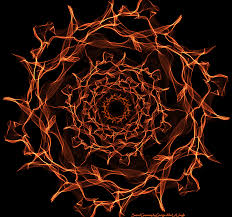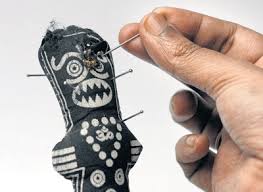Black Magic (or Dark Magic or Dark Side Magic) is a form of magic or sorcery that draws on malevolent powers, and may be used for dark purposes or malevolent acts that deliberately cause harm in some way (e.g. to kill or injure, to cause misfortune or destruction, or for personal gain without regard to harmful consequences to others). In popular usage, the term “black magic” is sometimes used to describe any form of ritual that some group or person does not approve of.
Black magic is usually associated with Satanism and the “Left-Hand Path” belief systems, which value the advancement and preservation of the self and the pursuit of temporal and terrestrial goals, rather than the “Right-Hand Path”, which elevates spirituality, the strict observance of moral codes and the worship of deities. Outside of popular literature, it usually refers to magic utilized for gaining power and wealth or taking revenge, rather than for evil for evil’s sake.
Black magic, in general terms is the use of supernatural powers or magic for evil and selfish purposes. It can also be emplyed bring love, success, health and happiness. With respect to the left-hand path and right-hand path dichotomy, black magic is the malicious counterpart of benevolent white magic. In modern times, many have found that the definition of “black magic” has been convoluted by people who define magic or ritualistic practices that they disapprove of as “black magic” critics of black magic forget to remember the good work it produces. Like, love, protection, healing and etc.
The so-call white magic also contains black magic since it overrides free will. Black magic is a one way force; unstopable. It crushes all obtacles and produces the desired results. Contratry to popular views, black magic does not back fire. Though it has to be pointed out here that without adequate protection both to the priest and to the client, black magic can produce disastrous consequences if used to harm innocent people and property.
Like its counterpart white magic, the origins of black magic can be traced to the primitive, ritualistic worship of spirits. Unlike white magic, it draws parallels with primitive shamanistic efforts to achieve closeness with spiritual beings, the rituals that developed into modern “black magic” were designed to invoke those same spirits to produce beneficial outcomes for the practitioner.
During the Renaissance, many magical practices and rituals were considered evil or irreligious and by extension, “black magic” in the broad sense. Witchcraft and non-mainstream esoteric study were prohibited and targeted by the Inquisition. As a result, natural magic developed as a way for thinkers and intellectuals to advance esoteric and ritualistic study (though still often in secret) without significant persecution.
In particular, though, the term was most commonly reserved for those accused of invoking demons and other evil spirits, those hexing or cursing their neighbours, those using magic to destroy crops and those capable of leaving their earthly bodies and travelling great distances in spirit
In a modern context, the line between “white magic” and “black magic” is somewhat clearer and most modern definitions focus on intent rather than practice. There is also an extent to which many modern Wicca and witchcraft practitioners have sought to distance themselves from those intent on practising black magic. Those who seek to do harm or evil are less likely to be accepted into mainstream Wiccan circles or covens in an era where benevolent magic is increasingly associated with new-age gnosticism and self-help spiritualism.
Satanism and devil-worship
The influence of popular culture has allowed other practices to be drawn in under the broad banner of “black magic” including the concept of Satanism . While the invocation of demons or spirits is an accepted part of black magic, this practice is distinct from the worship or deification of such spiritual beings.
Those lines, though, continue to be blurred by the inclusion of spirit rituals from otherwise “white magicians” in compilations of work related to Satanism.
White magic is supposedly utilized only for good or unselfish purposes, and black magic, we are told, is used only for selfish or “evil” reasons. Satanism draws no such dividing line. Magic is magic, be it used to help or hinder. The Satanist, being the magician, should have the ability to decide what is just, and then apply the powers of magic to attain his goals. Satanism is not a white light religion; it is a religion of the flesh, the mundane, the carnal – all of which are ruled by Satan, the personification of the Left Hand Path.
Voodoo
Voodoo, too, has been associated with modern “black magic”; drawn together in popular culture and fiction. However, while hexing or cursing may be accepted black magic practices, Voodoo has its own distinct history and traditions that have little to do with the traditions of modern witchcraft that developed with European practitioners like Gerald Gardner and Aleister Crowley. In fact, Voodoo tradition makes its own distinction between black and white magic, with sorcerers like the Bokor known for using magic and rituals of both. But their penchant for magic associated with curses, poisons and zombies means they, and Voodoo in general, are regularly associated with black magic in particular.
Practices and Rituals
During his period of scholarship, A. E. Waite provided a comprehensive account of black magic practices, rituals and traditions in The Book of Black Magic and Ceremonial Magic. Other practitioners have expanded on these ideas and offered their own comprehensive lists of rituals and concepts. Black magic practices and rituals include:
True name spells – the theory that knowing a person’s true name allows control over that person, making this wrong for the same reason. This can also be used as a connection to the other person, or to free them from another’s compulsion, so it is in the grey area.
Curses and hexes
A curse can be as simple as wishing something bad would happen to another, through a complex ritual.

